
The Thomisidae are a family of spiders, including about 175 genera and over 2,100 species. The common name crab spider is often linked to species in this family, but is also applied loosely to many other families of spiders. Many members of this family are also known as flower spiders or flower crab spiders.

Jumping spiders or the Salticidae are a family of spiders. As of 2019, it contained over 600 described genera and over 6000 described species, making it the largest family of spiders at 13% of all species. Jumping spiders have some of the best vision among arthropods and use it in courtship, hunting, and navigation. Although they normally move unobtrusively and fairly slowly, most species are capable of very agile jumps, notably when hunting, but sometimes in response to sudden threats or crossing long gaps. Both their book lungs and tracheal system are well-developed, and they use both systems. Jumping spiders are generally recognized by their eye pattern. All jumping spiders have four pairs of eyes, with the anterior median pair being particularly large.

Huntsman spiders, members of the family Sparassidae, are known by this name because of their speed and mode of hunting. They are also called giant crab spiders because of their size and appearance. Larger species sometimes are referred to as wood spiders, because of their preference for woody places. In southern Africa the genus Palystes are known as rain spiders or lizard-eating spiders. Commonly they are confused with baboon spiders from the Mygalomorphae infraorder, which are not closely related.

The Araneomorphae are an infraorder of spiders. They are distinguished by having chelicerae (fangs) that point diagonally forward and cross in a pinching action, in contrast to the Mygalomorphae, where they point straight down. Most of the spiders that people encounter in daily life belong to the Araneomorphae.

Lynx spider (Oxyopidae) is a family of araneomorph spiders first described by Tamerlan Thorell in 1870. Most species make little use of webs, instead spending their lives as hunting spiders on plants. Many species frequent flowers in particular, ambushing pollinators, much as crab spiders do. They tend to tolerate members of their own species more than most spiders do, and at least one species has been identified as exhibiting social behaviour.
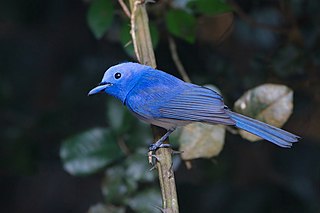
The black-naped monarch or black-naped blue flycatcher is a slim and agile passerine bird belonging to the family of monarch flycatchers found in southern and south-eastern Asia. They are sexually dimorphic, with the male having a distinctive black patch on the back of the head and a narrow black half collar ("necklace"), while the female is duller with olive brown wings and lacking the black markings on the head. They have a call that is similar to that of the Asian paradise flycatcher, and in tropical forest habitats, pairs may join mixed-species foraging flocks. Populations differ slightly in plumage colour and sizes.
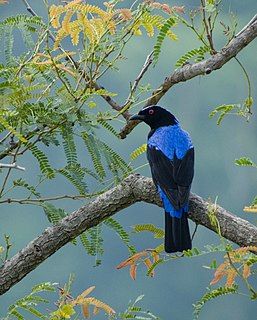
The Asian fairy-bluebird is a medium-sized, arboreal passerine bird.
Goleba is a genus of African jumping spiders that was first described by F. R. Wanless in 1980.

Nigma is a genus of cribellate araneomorph spiders in the family Dictynidae, and was first described by Pekka T. Lehtinen in 1967. They have a wide distribution, including Eurasia, North America, and Northern Africa. N. walckenaeri is one of the biggest members of the Dictynidae, growing up to 5 millimetres (0.20 in) long. They are translucent green and sometimes have red or black markings on the abdomen.

Hypothymis is a genus of birds in the family Monarchidae.

The pale-blue monarch is a small passerine bird in the family Monarchidae endemic to eastern Indonesia.
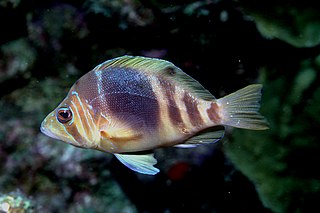
Hypoplectrus puella, the barred hamlet is a species of marine ray-finned fish, a sea bass from the subfamily Serraninae which is part of the family Serranidae, which also includes the groupers and anthias. This species is from the Western Central Atlantic. It occasionally makes its way into the aquarium trade.
Pleurotomella puella is a species of sea snail, a marine gastropod mollusk in the family Raphitomidae.
Vexillum puella is a species of small sea snail, marine gastropod mollusk in the family Costellariidae, the ribbed miters.

Spiders are air-breathing arthropods that have eight legs, chelicerae with fangs generally able to inject venom, and spinnerets that extrude silk. They are the largest order of arachnids and rank seventh in total species diversity among all orders of organisms. Spiders are found worldwide on every continent except for Antarctica, and have become established in nearly every habitat with the exceptions of air and sea colonization. As of July 2019, at least 48,200 spider species, and 120 families have been recorded by taxonomists. However, there has been dissension within the scientific community as to how all these families should be classified, as evidenced by the over 20 different classifications that have been proposed since 1900.

Puella Magi Madoka Magica, also known simply as Madoka Magica, is a 2011 Japanese anime television series created by Magica Quartet and animated by Shaft. The story follows a group of middle school girls, led by protagonist Madoka Kaname, who make supernatural contracts to become magical girls. In battling surreal enemies known as "witches", they learn of the anguish and peril associated with their new roles.
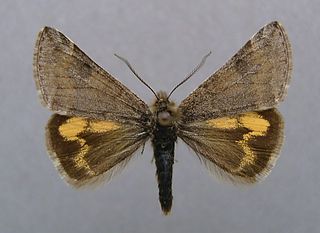
Boudinotiana puella, the pale orange underwing, is a moth of the family Geometridae. The species was first described by Eugen Johann Christoph Esper in 1787. It is found in isolated populations in central Europe, ranging to southern Russia in the east.
Glenea puella is a species of beetle in the family Cerambycidae. It was described by Chevrolat in 1858.
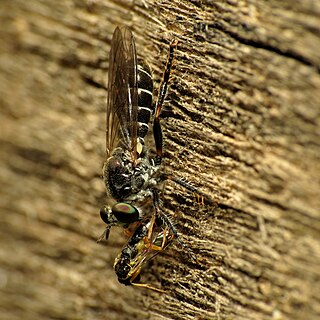
Atomosia puella is a species of robber flies in the family Asilidae.

Delphacodes puella is a species of delphacid planthopper in the family Delphacidae. It is found in the Caribbean, Central America, North America, and South America.
















